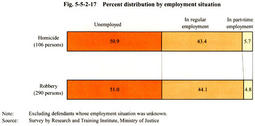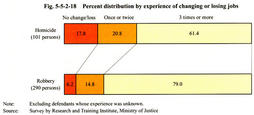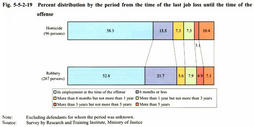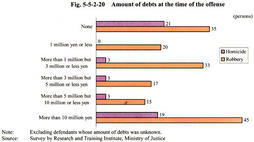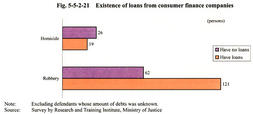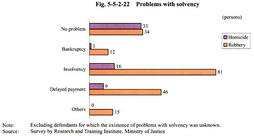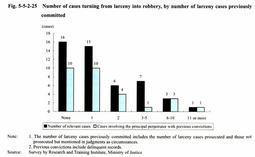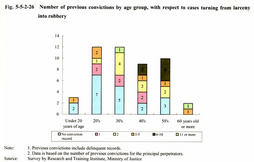| Previous Next Index Image Index Year Selection | |
|
|
2 Analysis on motives/background factors Fig. 5-5-2-16 shows motives for committing robbery. Although the majority are cases of robbery resulting in death, the motives for committing such a serious offense are not limited to obtaining living expenses for the defendants themselves or their families but include motives that are remotely related to poverty, such as obtaining entertainment expenses. Furthermore, motives relating to debts, such as obtaining money for debt repayment and exempting from debts, are more common among the serious cases targeted in the survey than among robbery cases in general. Looking at the process of the offense in more detail, we can see there are many cases in which the defendants in financial difficulties asked for loans from their associates or friends (including those who had or had not previously offered loans to the defendants), and when refused, they took the simplistic act of robbing such people of money or articles by killing them. In the robbery group, 22 cases fall under this category of offense of "turning from asking for a loan to committing robbery." It is revealed that, as mentioned above, while some robbery cases are committed for the purpose of taking a large amount of assets while designing the perfect crime and making full preparations therefore, many cases are committed with such a simplistic motive.
Fig. 5-5-2-16 Motives for committing robbery (2) Offenses committed by people with multiple debts Chapter 3, Section 5 has already clarified the increase in the number of unemployed persons among persons cleared, mentioning, as background factors for such overall trend, the rising unemployment rate and the increase in the number of petitions for bankruptcy newly received and in the number of inquiries for consultation on multiple debts. This special survey further examined the serious robbery/homicide cases, focusing on the following 7 financial background factors: (i) defendant's employment situation; (ii) defendant's experience of changing or losing jobs; (iii) period from the time of the last job loss until the time of the offense; (iv) amount of debts at the time of the offense; (v) existence of loans from consumer finance companies; (vi) defendant's solvency at the time of the offense; (vii) reasons for getting loans.
Fig. 5-5-2-17 , Fig. 5-5-2-18 , Fig. 5-5-2-19 show the defendant's employment situation at the time of the offense, the defendant's experience of changing or losing jobs, and the period from the time of the last job loss until the time of the offense, respectively. As for robbery, the majority of the defendants are unemployed persons and those who have changed or lost jobs 3 times or more account for 79.0%, suggesting unstable employment situations among robbery offenders. With respect to the period from the time of the last job loss until the time of the first robbery offense, the percentage of only six months or less is the largest and the period is generally shorter among the defendants in therobbery cases than among those in the homicide cases, which indicates that job loss had an influence on the commitment of the offense in a considerable number of robbery cases. Fig. 5-5-2-20 , Fig. 5-5-2-21 , Fig. 5-5-2-22 , Fig. 5-5-2-23 show the amount of debts at the time of the offense (excluding cases in which debts existed but the amount thereof was unknown), the existence of loans from consumer finance companies, the defendant's solvency, and reasons for getting loans, respectively. In the robbery group, the majority of the defendants had debts or problems with solvency, which suggests that the debt problem is a major factor for deciding to commit robbery. With respect to the amount of debts, the percentage of the defendants who had a large amount of debts over 10 million yen is the largest whereas the total percentage of those who had debts of 3 million yen or less is larger than the percentage of those who had a larger amount of debts, which indicates that a considerable number of defendants, whose amount of debts was relatively small, went as far as to commit robbery, a serious offense. Persons who had loans from consumer finance companies account for 66.1% of the defendants in the robbery cases (including defendants for which the existence of such loans is unknown), and 57.9% of those who had loans from consumer finance companies were in multiple debts (borrowing money from 2 or more financial businesses; hereinafter the same in this subsection). The amount of loans provided from consumer finance companies has been increasing significantly in recent years and the number of users of such loans has been increasing accordingly regardless of age. Consumer finance is convenient but likely to cause economic failure when used repeatedly without planning. A considerable number of persons among the defendants targeted in this survey got loans from consumer finance companies repeatedly without careful consideration and finally fell into difficulties with multiple debts. With respect to reasons for getting loans (not limited to those from consumer finance companies), obtaining entertainment/gambling expenses was the most common, which suggests that many persons who have piled up loans for such a simplistic purpose of obtaining entertainment expenses and fell into financial difficulties go as far as to commit robbery with the aim of getting out of their current situation. Fig. 5-5-2-17 Percent distribution by employment situation Fig. 5-5-2-18 Percent distribution by experience of changing or losing jobs Fig. 5-5-2-19 Percent distribution by the period from the time of the last job loss until the time of the offense Fig. 5-5-2-20 Amount of debts at the time of the offense Fig. 5-5-2-21 Existence of loans from consumer finance companies Fig. 5-5-2-22 Problems with solvency Fig. 5-5-2-23 Reasons for getting loans (3) Turning from larceny into robbery Both larceny and robbery are types of offenses committed for the purpose of obtaining gains by taking property from others. Considering that the acts of using violence or threat in order to prevent the recovery of stolen property, to escape arrest, or to destroy the evidence of larceny is punishable as constructive robbery, larceny and robbery are extremely close to each other. Generally, habitual thieves or persons who have previously been convicted of larceny often commit robbery. The majority of persons reimprisoned for robbery have previously been imprisoned for robbery or larceny (discussed in Chapter 6 ).
In the robbery group of serious cases targeted in this survey, 80 defendants have previous convictions("previous convictions" includes criminal histories in the following paragraphs and figures of this subsection (3).) for robbery or larceny. Fig. 5-5-2-24 shows the percent distribution of those who have previous convictions for robbery or larcerfy, by number of previous convictions for robbery or larceny. Many have previous convictions at multiple times. In more detail, there are many cases that turned into robbery in the process of committing larceny and finally ended in homicide on the occasion of robbery or robbery resulting in death. Among the robbery cases targeted in this survey, 48 cases are regarded as offenses "turning from larceny into robbery," falling under any of the following: (i) where the principal perpetrator has previous convictions for larceny; (ii) where the perpetrator has committed larceny prior to committing the robbery offense concerned (including larceny cases prosecuted and those not prosecuted but mentioned in judgments as circumstances for sentencing); (iii) where the perpetrator has committed robbery after setting about committing larceny (e.g. constructive robbery or robbery committed by threatening with violence when detected). Among these 48 cases, 29 cases fall under (i), 32 cases fall under (ii), and 16 cases fall under (iii). Fig. 5-5-2-25 shows the number of cases "turning from larceny into robbery," by number of larceny cases previously committed. The serious robbery cases targeted in this survey include many cases in which the Perpetrators have previous convictions for larceny and cases in which the perpetrators have not only committed larceny but also committed robbery for the purpose of taking more money or articles. This indicates that larceny is likely to turn into robbery or homicide on the occasion of robbery depending on the circumstances. Fig. 5-5-2-26 shows the relationship between the age group of the principal perpetrator and the number of his/her previous convictions for larceny, with respect to the cases "turning from larceny into robbery." Except for the under 20 age group, for which the number of relevant persons is small, the share of those with many previous convictions for larceny is larger in older age groups. This implies that many of elderly people who have many previous convictions larceny commit robbery. Fig. 5-5-2-24 Number of previous convictions for robbery/larceny Fig. 5-5-2-25 Number of cases turning from larceny into robbery, by number of larceny cases previously committed Fig. 5-5-2-26 Number of previous convictions by age group, with respect to cases turning from larceny into robbery (4) Others There are 4 cases of random killings, in which the perpetrators injured or killed passers-by, with whom they had no acquaintance or interest, without particular motives. All these cases were committed by drug addicts or people with personality disorders who had poor histories or backgrounds, always felt dissatisfied, and whose anger that has been pent-up by their own self-centered illusions finally explodes, damaging people who are not related to them. Perpetrators of this kind of offense choose targets at random and do not care at all about the possibility of being arrested, acting under the influence of strong emotion. For this reason, this unreasonable offense contains a serious danger of resulting in mass killing.
|

